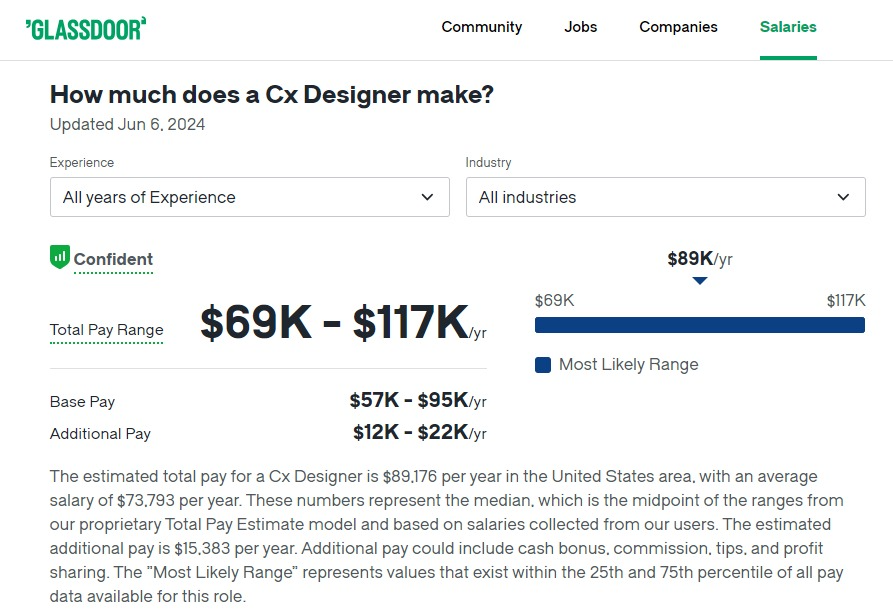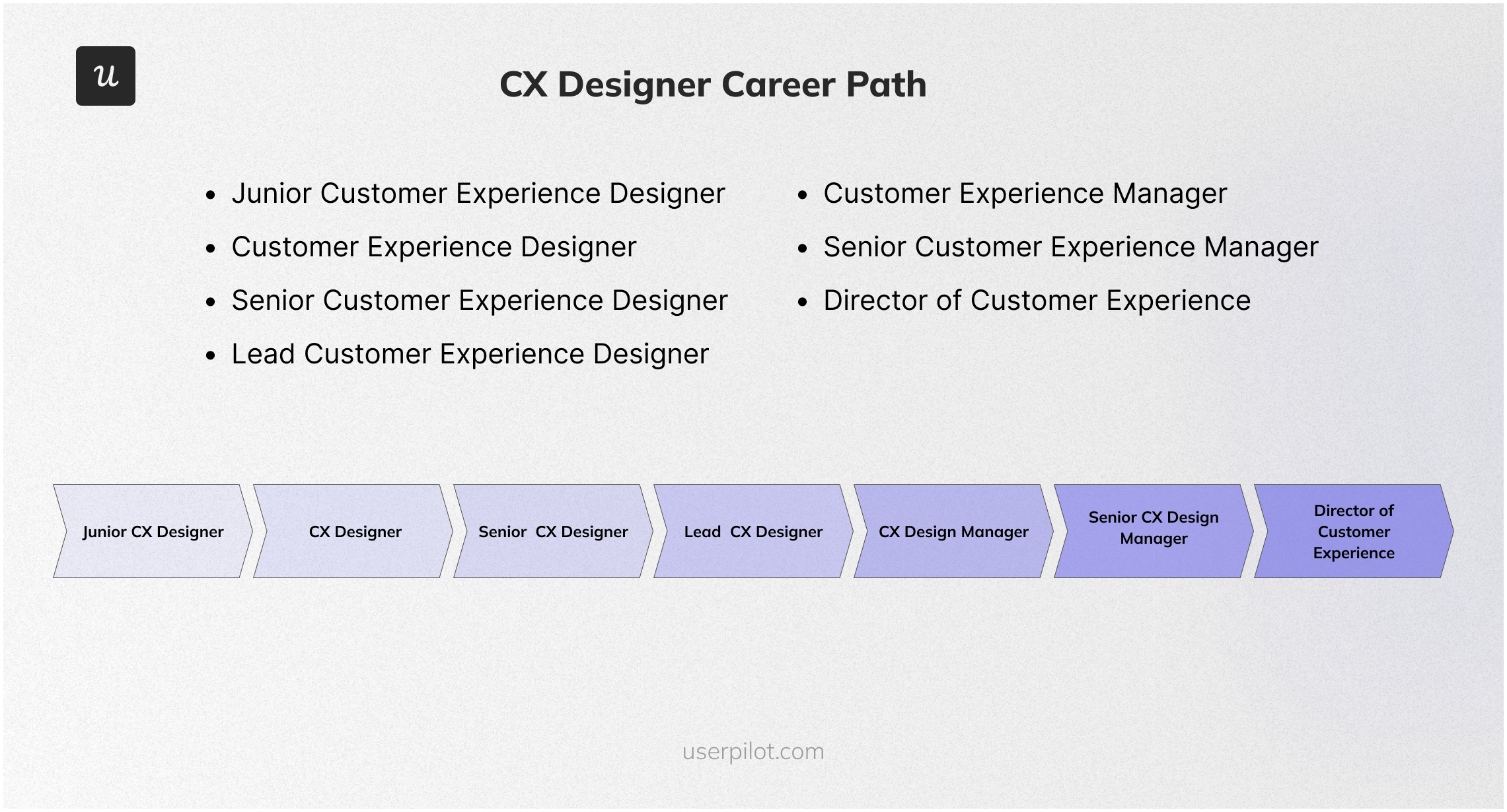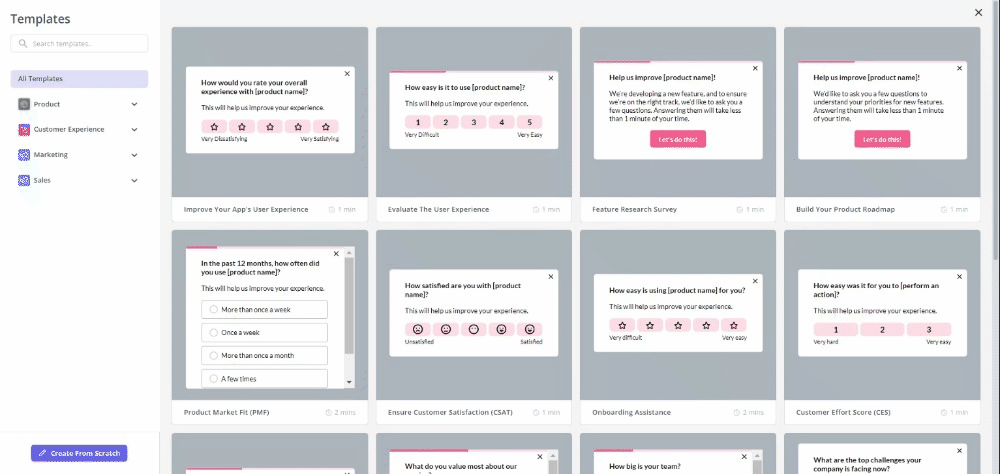
Try Userpilot Now
See Why 1,000+ Teams Choose Userpilot

What is a CX designer – quick summary
- A customer experience Designer (CX Designer) focuses on creating and optimizing the interactions that customers have with a company’s products or services.
- This role is dedicated to enhancing every touchpoint in the customer journey to ensure a seamless, engaging, and satisfying experience. In the SaaS industry, a CX Designer uses user research, data analysis, and design thinking to improve user interfaces, streamline onboarding processes, and ensure ongoing customer satisfaction.
- Customer experience designers are essential in crafting seamless and engaging user journeys. Their salaries vary significantly based on experience, industry, location, and the company they work for. Here’s an example of customer experience designers’ salary by experience level:
- Entry-Level (0-2 years): Typically earns between $54,380 and $60,998 per year.
- Mid-Level (3-5 years): Average salary ranges from $60,998 to $69,787 annually.
- Senior-Level (5+ years): Generally earns between $69,787 and $76,248 per year.
- Looking into tools for CX designers? Userpilot is an all-in-one product platform with engagement features and powerful analytics capabilities. Book a demo to see it in action!
What is a CX designer?
A customer experience Designer (CX Designer) focuses on creating and optimizing the interactions that customers have with a company’s products or services.
This role is dedicated to enhancing every touchpoint in the customer journey to ensure a seamless, engaging, and satisfying experience. In the SaaS industry, a CX Designer uses user research, data analysis, and design thinking to improve user interfaces, streamline onboarding processes, and ensure ongoing customer satisfaction.
They collaborate closely with product managers, developers, and marketing teams to align the product’s design with the overall business goals and customer needs.
What does a CX designer do?
A Customer Experience Designer (CX designer) is responsible for crafting and optimizing the entire journey a customer takes when interacting with a company’s product or service.
This role involves conducting user research to gather insights on customer needs and pain points, designing intuitive user interfaces and interactions, and creating detailed customer journey maps.
CX designers work collaboratively with product managers, developers, and marketing teams to ensure a cohesive and engaging experience across all touchpoints. They use data analysis to identify trends and make informed design decisions, continually iterating on prototypes and testing to enhance the overall user experience.
Their ultimate goal is to ensure customer satisfaction, loyalty, and retention by making every interaction with the product seamless and enjoyable.
CX designer’s main responsibilities
A customer experience designer plays a crucial role in the SaaS industry, focusing on optimizing the entire customer journey to enhance satisfaction and loyalty. Here are the main responsibilities and duties of a customer experience designer:
- Conduct User Research: Gather insights into customer needs, behaviors, and pain points through surveys, interviews, and usability testing to inform design decisions.
- Develop Customer Journey Maps: Create detailed journey maps that visualize the end-to-end customer experience, identifying key touchpoints and opportunities for improvement.
- Design User Interfaces and Interactions: Craft intuitive and visually appealing user interfaces and interactions that enhance the overall user experience across all touchpoints.
- Collaborate with Cross-Functional Teams: Work closely with product managers, developers, marketers, and other stakeholders to ensure a cohesive and seamless customer experience.
- Analyze Customer Data: Utilize customer feedback and data analytics to identify trends, measure the effectiveness of design solutions, and make data-driven improvements.
- Create and Test Prototypes: Develop prototypes of new features or improvements and conduct usability testing to gather feedback and refine designs before implementation.
- Ensure Consistency in Design: Maintain design consistency across all customer-facing products and platforms, adhering to brand guidelines and design standards.
- Monitor and Evaluate Customer Experience: Continuously monitor and evaluate the customer experience, implementing iterative improvements based on user feedback and evolving customer needs.
- Advocate for Customer-Centric Design: Promote user-centered design principles within the organization, ensuring that customer needs are prioritized in all design and development efforts.
- Stay Updated with Industry Trends: Keep abreast of the latest trends, tools, and best practices in customer experience design to bring innovative ideas to the team.
CX designer salary
Customer experience designers are essential in crafting seamless and engaging user journeys. Their salaries vary significantly based on experience, industry, location, and the company they work for.
Salary by Experience Level
- Entry-Level (0-2 years): Typically earns between $54,380 and $60,998 per year.
- Mid-Level (3-5 years): Average salary ranges from $60,998 to $69,787 annually.
- Senior-Level (5+ years): Generally earns between $69,787 and $76,248 per year.
Salary by Industry
- Technology: $70,000 to $90,000 per year.
- Finance: $65,000 to $85,000 annually.
- Healthcare: $60,000 to $80,000 per year.
- Retail: $55,000 to $75,000 annually.
Salary by Location
- San Francisco, CA: Around $76,248 per year.
- New York, NY: Approximately $71,246 per year.
- Boston, MA: Around $68,379 per year.
- Chicago, IL: About $63,987 per year.
- Miami, FL: Approximately $58,863 per year.
Highest Paying Companies
- Amazon
- Apple
- Facebook (Meta)
- Microsoft
These figures provide a comprehensive overview of how a Customer Experience Designer’s salary can vary. For the most accurate and detailed information, consulting sources like Glassdoor, Salary.com, and Payscale are recommended.
CX designer career path
Progressing in a career as a customer experience designer typically involves moving through various roles that build on increasing responsibility and expertise. Here’s a typical career progression:
- Junior Customer Experience Designer – Entry-level position focused on assisting senior designers, conducting user research, and creating basic design components. To progress, focus on learning design tools, building a portfolio, and gaining practical experience.
- Customer Experience Designer – Responsible for designing user interfaces and experiences, conducting usability tests, and collaborating with cross-functional teams. To advance, take on more complex projects and deepen your understanding of user-centered design principles.
- Senior Customer Experience Designer – Leads major design projects, mentors junior designers, and plays a key role in strategic design decisions. Enhance leadership skills, contribute to creating design systems, and build strong relationships with other departments.
- Lead Customer Experience Designer – Oversees the design team, ensures design consistency across projects, and aligns design goals with business objectives. Develop project management skills and engage in high-level strategic planning.
- Customer Experience Manager – Manages the customer experience design team, coordinates design projects, and ensures alignment with business goals and user needs. Enhance leadership and managerial skills, stay updated with industry trends, and focus on optimizing team performance and design processes.
- Senior Customer Experience Manager – Manages larger design teams, oversees multiple projects, and plays a critical role in company-wide design strategy. Develop a vision for the customer experience department and mentor upcoming leaders.
- Director of Customer Experience – Sets the overall customer experience strategy for the company, collaborates with top executives, and ensures the design vision aligns with the company’s mission. Focus on strategic leadership and drive the company’s customer experience innovation.
Each step in this career path builds on the previous one, emphasizing continuous learning, leadership, and strategic thinking to progress to higher levels of responsibility and influence in the field of customer experience design.
Best practices for being a great CX designer
As a customer experience designer, it is essential to adopt practices that enhance user satisfaction and streamline design processes. Here are some best practices:
- Empathize with Users: Understand and prioritize the needs, behaviors, and pain points of users. Conduct thorough user research to gather valuable insights that inform your design decisions.
- Collaborate Effectively: Work closely with cross-functional teams, including product managers, developers, and marketers. Effective collaboration ensures that design solutions are cohesive and aligned with business goals.
- Focus on Usability: Ensure that designs are intuitive and easy to use. Conduct usability testing to identify and resolve issues, enhancing the overall user experience.
- Iterate Based on Feedback: Embrace an iterative design process. Regularly gather user feedback and make necessary adjustments to improve the product continuously.
- Stay Updated with Trends: Keep abreast of the latest design trends, tools, and technologies. Continuous learning and adapting to new methods help in creating innovative and effective designs.
- Create Detailed User Journeys: Develop comprehensive user journey maps to visualize the entire customer experience. This helps in identifying touchpoints and opportunities for improvement.
By integrating these best practices into your workflow, you can significantly improve the quality of your designs and the overall customer experience.
CX designer FAQs
- What is designing customer experience? Designing customer experience involves creating and optimizing all interactions customers have with a brand, ensuring a seamless and satisfying journey from start to finish.
- What is the difference between CX and UX? CX covers the entire customer journey across all touchpoints with a brand, while UX focuses specifically on the interaction between users and a product or service.
- What is the meaning of experience designer? A customer experience designer creates and optimizes user interactions with products, services, or brands to ensure engaging, efficient, and enjoyable experiences.
- How do I become a user experience designer? Obtain a degree in design, human-computer interaction, or a related field, gain practical experience through internships, build a strong portfolio, and consider specialized courses or certifications in UX design.
- Is CX a good career? Yes, CX is a growing field with high demand, offering opportunities to improve customer interactions and brand loyalty, with competitive salaries and career advancement potential.
Conclusion
We hope this guide has provided you with valuable insights into the roles, responsibilities, and rewards associated with this role.
Looking into tools for CX designers? Userpilot is an all-in-one product platform with engagement features and powerful analytics capabilities. Book a demo to see it in action!









